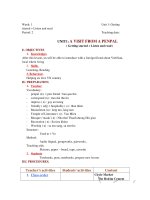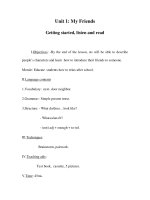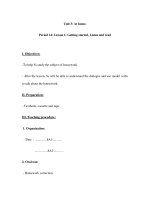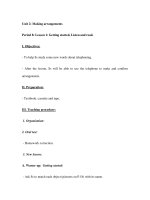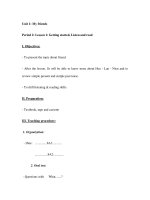Unit 1 get started with translation
Bạn đang xem bản rút gọn của tài liệu. Xem và tải ngay bản đầy đủ của tài liệu tại đây (385.91 KB, 5 trang )
Translation course – Unit 1: Let’s Get Started With Translation
Unit 1: Let’s get started with translation
1. Translate the following paragraphs into your local language:
1.1. Translation
Translation is the interpreting of the meaning of a text and the subsequent production of
an equivalent text, likewise called a "translation," that communicates the same message
in another language. The text to be translated is called the source text, and the language
that it is to be translated into is called the target language; the final product is sometimes
called the target text.
Translation must take into account constraints that include context, the rules of grammar
of the two languages, their writing conventions, and their idioms. A common
misconception is that there exists a simple word-for-word correspondence between any
two languages, and that translation is a straightforward mechanical process; such a wordfor-word translation, however, cannot take into account context, grammar, conventions,
and idioms.
Translation, when practiced by relatively bilingual individuals but especially when by
persons with limited proficiency in one or both languages, involves a risk of spilling-over
of idioms and usages from the source language into the target language. On the other
hand, inter-linguistic spillages have also served the useful purpose of importing calques
and loanwords from a source language into a target language that had previously lacked a
concept or a convenient expression for the concept. Translators and interpreters,
professional as well as amateur, have thus played an important role in the evolution of
languages and cultures.
Subsequent production:
Word-for-word:
Source text:
Correspondence:
Target language
Mechanical process:
Target text.
Limited proficiency :
Context:
Spilling-over :
Writing conventions:
Inter-linguistic spillages:
Misconception:
Calques:
© Nguyen Trung Kien
FOTIC - UIA
1
Translation course – Unit 1: Let’s Get Started With Translation
1.2. Petrol prices unchanged despite world price fall
HA NOI — Petrol retailers will hold the pump price of petrol on the domestic market,
despite a decline in wholesale prices, and instead pay a fee to the petrol price stabilisation
fund.
This follows a decision on Saturday by the ministries of Finance and Industry and Trade,
and comes only a short time after it allowed petrol and oil retail prices to increase by
VND 1,000 to VND 15,700 per litre of A92 petrol, VND 13,100 per litre of diesel oil and
VND 14,000 per litre of kerosene1 on August 30.
In the early 20 days of this month, world petrol and oil prices fell 5.3 per cent for A92
petrol, 4.42 per cent for kerosene and 3.42 per cent for diesel oil compared with last
month, the ministries said.
1
: Dầu lửa
1.3. Caravan tours
Caravan tours were becoming more popular in Viet Nam, but tourists had to complete
cumbersome and time-consuming procedures. Most tourists of this kind were high
income earners requiring high-quality services, he said.
In recent years, many caravan tours from Thailand and Laos have visited Viet Nam,
contributing to increased tourism traffic in the Central Highlands and central regions.
Sometimes, the overland international border gates at the regions received up to 2,000
international tourists a day, Binh said.
However, concerned provinces and the domestic tourism industry still had no specific
plans to attract tourists of this kind.
To attract international overland tourists to Viet Nam, border provinces, particularly
those in the Tay Nguyen and central regions, must attach priority to building tourism
infrastructural facilities and ensure high quality services, Binh said.
He also stressed the need to set up close cooperation between Viet Nam and neighbouring
countries including Thailand, Laos, Cambodia and China in developing international
overland tourism including caravan tours. — VNS
© Nguyen Trung Kien
FOTIC - UIA
2
Translation course – Unit 1: Let’s Get Started With Translation
2. Translate the following paragraphs into your English:
2.1. ADB nâng mức dự báo tăng trưởng của Việt Nam lên 4,7%
(ND) Nhờ những phản ứng chính sách nhanh chóng và mạnh mẽ của Chính phủ, trong
một báo cáo công bố hôm nay, Ngân hàng Phát triển Châu Á (ADB) đã nâng dự báo tăng
trưởng đối với Việt Nam năm 2009 từ 4,5% (hồi tháng 3-2009) lên 4,7% và giữ nguyên
mức dự báo tăng trưởng 6,5% cho năm 2010.
Tuy nhiên, báo cáo đã nhấn mạnh sự cần thiết đối với Chính phủ về việc đảm bảo cân
bằng giữa kích thích tăng trưởng thông qua các biện pháp kích cầu và giữ vững ổn định
kinh tế vĩ mô. (Nhan Dan Newspaper)
2.2. Report translation
“Giai đoạn đầu của Dự án gồm hai giai đoạn này đang được thực hiện tại 04 tỉnh: Nam
Định, Ninh Bình, Hải Dương và Thái Bình. Trong giai đoạn này có khoảng 28-30 xã
trong mỗi tỉnh sẽ được phục vụ, đưa số xã được phục vụ lên khoảng 120 xã với tổng số
dân khoảng 800.000 người. Uỷ ban nhân dân tỉnh (PPC’s) chịu trách nhiệm thực hiện dự
án thông qua Sở nông nghiệp và phát triển nông thôn (DARD’s) của từng tỉnh, Sở này
thành lập ra Ban quản lý dự án của tỉnh (PPMU’s) để thực thi nhiệm vụ.”
2.3. Nghệ sĩ guitare nổi tiếng của Pháp biểu diễn tại Hà Nội
Thibault Cauvin là một trong những nghệ sĩ guitare trẻ được yêu thích nhất hiện nay,
không chỉ ở Paris, quê hương anh mà còn ở nhiều thành phố khác trên thế giới, nơi anh
đến trình diễn. Anh đã trình tấu tại những nhà hát danh tiếng của các thành phố New
York, Singapour, Sao Paolo, Istanbul, Luân Đôn, Melbourne, Séoul và Tanger...
Mới 24 tuổi, anh đã thực hiện hơn 600 buổi hòa nhạc trên khắp các lục địa và được giới
phê bình nhất trí đánh giá cao. Anh cũng tham gia nhiều chương trình truyền hình, phát
thanh và cộng tác với nhiều nhạc công, nhạc sĩ và dàn nhạc giao hưởng nổi tiếng. Mặc dù
tuổi đời còn khá trẻ, Thibault vẫn thường xuyên được các nhạc viện, trường đại học và
liên hoan âm nhạc trên khắp thế giới chọn làm khách mời cho các master-class, các hội
thảo hay giám khảo các cuộc thi.
© Nguyen Trung Kien
FOTIC - UIA
3
Translation course – Unit 1: Let’s Get Started With Translation
2.4. Certificate translation
Further reading: Principles of Translation (Alan Duff, 1990)
© Nguyen Trung Kien
FOTIC - UIA
4
Translation course – Unit 1: Let’s Get Started With Translation
Below are some general principles which are relevant to all translation:
a. Meaning. The translation should reflect accurately the meaning of original text.
Nothing should be arbitrarily added or removed.
b. Form. The ordering of words and ideas in the translation should match the originals as
closely as possible. When in doubt, underline in the original text the words on which the
main stress falls.
c. Register. Language often differs greatly in their levels of formality in a given context.
To resolve these differences, the translator must distinguish between formal or fixed
expressions and personal expressions, in which the write sets the tone.
d. Source language influence. One of the most frequent criticisms of translation is that
'it doesn't sound natural’. This is because the translator's thoughts and choice of words are
too strongly influenced by the original text. A good way of avoiding the SL influence is
to translate naturally using the idiomatic target language.
e. Style and clarity. The translator should not change the style of the original, but if the
text is sloppily written, or full of repetitions, the translator may, for the reader's sake,
correct the defects.
f. Idiom. Idiomatic expressions are notoriously untranslatable. These include similes,
metaphors, proverbs and saying, jargon, slang and colloquialisms and phrasal verbs. If
the expressions can not be directly translated, try any of the following:
- Retain the original word, in inverted commas: 'yumcha', 'phở', 'chèo'
- Retain the original expression with a literal explanation in brackets:
'áo dài' (a long close-fitting blouse)
'thồ' (a taxi bike or a taxi motorbike...)
'acre' (đơn vị đo diện tích tương đương 4.000 m2)
The golden rule is: if the idiom does not work in the L1, do not force it into translation.
© Nguyen Trung Kien
FOTIC - UIA
5
